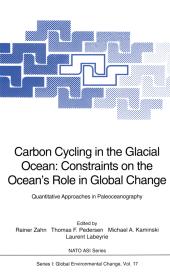 Neuerscheinungen 2011Stand: 2020-01-07 |
Schnellsuche
ISBN/Stichwort/Autor
|
Herderstraße 10
10625 Berlin
Tel.: 030 315 714 16
Fax 030 315 714 14
info@buchspektrum.de |

Michael A. Kaminski, Laurent Labeyrie, Thomas F. Pedersen, Rainer Zahn
(Beteiligte)
Carbon Cycling in the Glacial Ocean: Constraints on the Oceanīs Role in Global Change
Quantitative Approaches in Paleoceanography
Herausgegeben von Zahn, Rainer; Pedersen, Thomas F.; Kaminski, Michael A.; Labeyrie, Laurent
Softcover reprint of the original 1st ed. 1994. 2011. xiii, 580 S. XIII, 580 pp. 235 mm
Verlag/Jahr: SPRINGER, BERLIN 2011
ISBN: 3-642-78739-8 (3642787398)
Neue ISBN: 978-3-642-78739-3 (9783642787393)
Preis und Lieferzeit: Bitte klicken
Proceedings of the NATO Advanced Research Workshop on Carbon Cycling in the Glacial Ocean: Constraints on the Oceanīs Role in Global Change, held at Fellhorst, Germany, September 17 - 19, 1992
A comprehensive progress report on the multi-disciplinary field of ocean and climate change research is given. It compiles introductory background papers and leading scientific results on the ocean-atmosphere carbon cycle with emphasis on the oceanīs carbon inventory and the various components involved. The relationship between plankton productivity, carbon fixation, oceanic PCO2 and climate change is investigated from the viewpoint of long-term climatic change during the late Quaternary cycles of ice ages and warm ages. The various approaches range from micropaleontology over organic and trace element geochemistry to molecular isotope geochemistry.
I - Operation of the Ocean-Atmosphere Carbon Cycle.- The recent state of carbon cycling through the atmosphere.- Glacial ocean carbon cycle modeling.- Glacial-interglacial changes in continental weathering: possible implication for atmospheric CO2.- II - Variations of the Oceanīs Carbon Reservoir: Faunal versus Geochemical Records.- The relationship between surface water masses, oceanographic fronts and paleoclimatic proxies in surface sediments of the Greenland, Iceland, Norwegian Seas.- Is there a relationship between atmospheric CO2 and manganese in the ocean?.- Benthic foraminiferal assemblages and the ?13C-signal in the Atlantic sector of the Southern Ocean: glacial-to-interglacial contrasts.- Foraminiferal population dynamics and stable carbon isotopes.- A comparison of carbon isotopes and cadmium in the modern and glacial maximum ocean: can we account for the discrepancies?.- Tracer-nutrient correlations in the upper ocean: observational and box model constraints on the use of benthic foraminiferal ?13C and Cd/Ca as paleo-proxies for the intermediate-depth ocean.- III - Geochemistry of the Organic Sediment Fraction: Constraints on the Biological Carbon Pump.- Possible early diagenetic alteration of palaeo proxies.- Nitrogen isotope fractionation in the modern ocean: implications for the sedimentary record.- The use of nitrogen isotopic ratio for reconstruction of past changes in surface ocean nutrient utilization.- Variations in sedimentary organic ?13C as a proxy for past changes in ocean and atmospheric CO2 concentrations.- Reconstruction of paleoceanic PCO2 levels from carbon isotopic compositions of sedimentary biogenic components.- Late Quaternary PCO2 variations in the Angola Current: evidence from organic carbon ?13C and alkenone temperatures.- PCO2 variations of equatorial surface water over the last 330,000 years: the ?13C record of organic carbon.- IV - Geochemical and Micropaleontological Indexes of Paleoproductivity.- Paleoproductivity: flux proxies versus nutrient proxies and other problems concerning the Quaternary productivity record.- From modern flux to paleoflux: assessment from sinking assemblages to thanatocoenosis.- Late Quaternary paleoproductivity variations in the NE and equatorial Atlantic: diatom and Corg evidence.- Glacial-Holocene paleoproductivity off western Australia: a comparison of proxy records.- Nutrient, mixing and export indices: A 250 Kyr paleoproductivity record from the western equatorial Pacific.- Dinoflagellate cysts as paleoproductivity indicators: state of the art, potential, and limits.- Deep-sea benthic foraminifers: food and bottom water masses.- The history of barium, biogenic silica and organic carbon accumulation in the Weddell Sea and Antarctic Ocean over the last 150,000 years.


